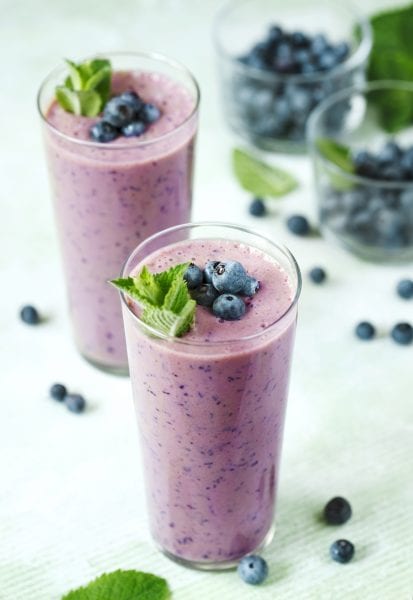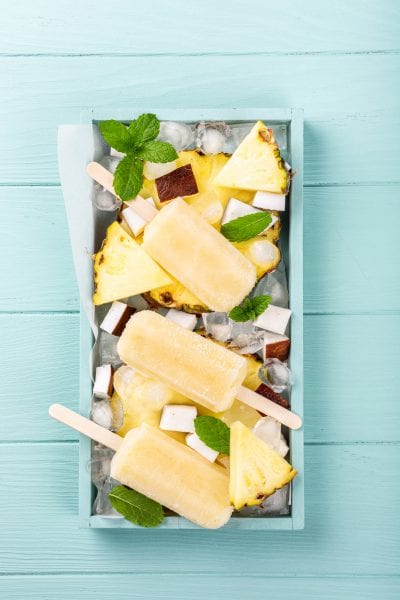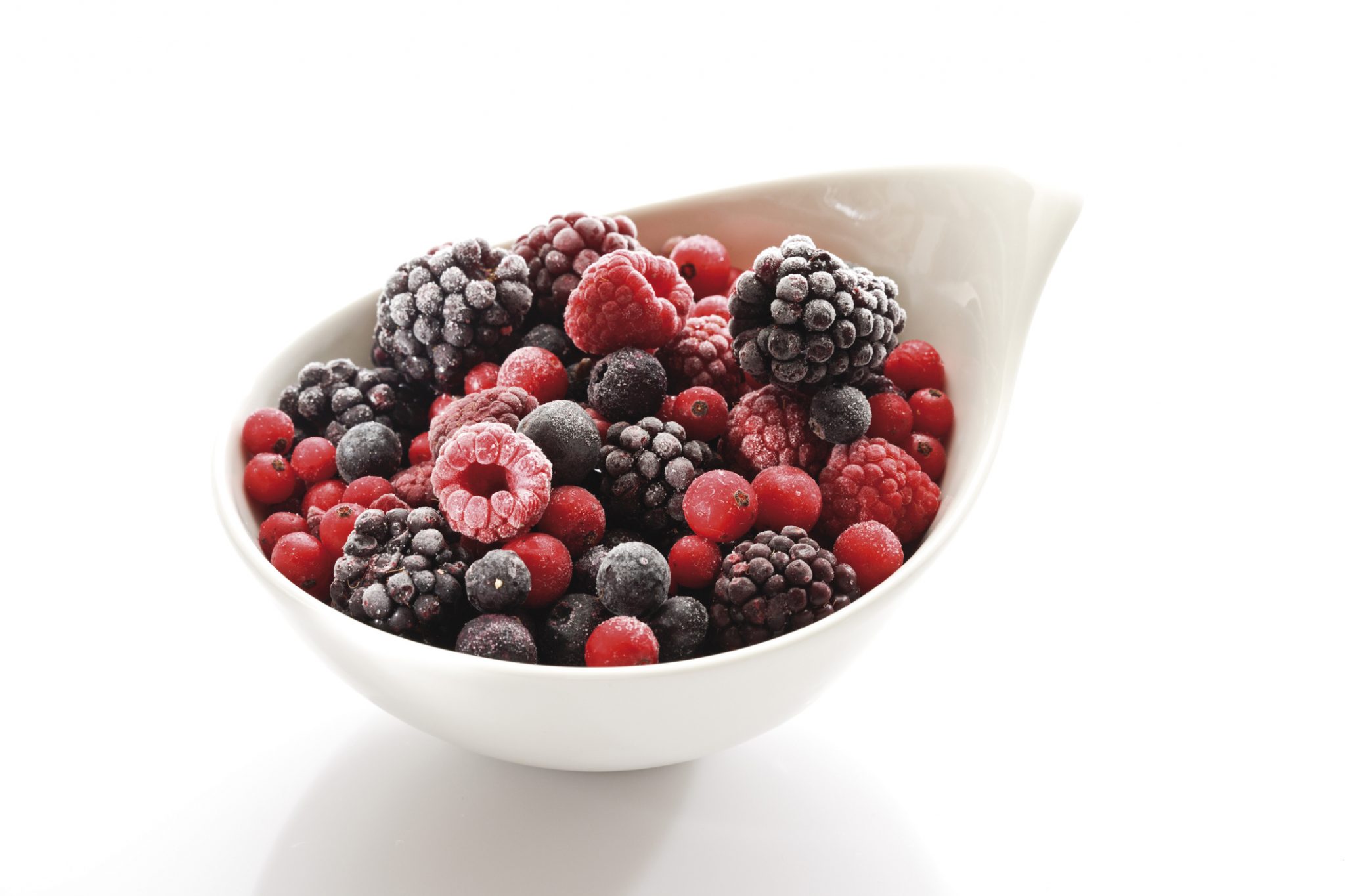Food Safety

Freezing fresh fruit to retain optimal texture and nutrients is as easy as following a few simple, proven steps.
Fruits can be frozen and still be as appetizing and tasty as fresh fruit if they are properly selected, prepared, packaged, frozen, stored, and thawed. Skipping just one step, however, can damage the quality and nutritional value of your fruit.
Select the Best Ripeness and Variety for Freezing
Fruit selected for freezing should be firm-ripe, meaning ripe enough to eat. It will have the flavor, color, texture, and nutrients that are characteristic of the fruit. Peaches, berries, etc., are not good to eat when they are soft, so they won’t be good after they have been frozen and thawed. The same is true of underripe fruit. Generally, if the fruit is good to eat fresh, it will freeze well too.
It is best to pick fruit from the bush or tree so that it won’t be bruised. Fruits prepared for freezing within 12 hours after picking are better than those kept a longer time.
Fruit varieties known to freeze well include the following:
- Peaches. Some varieties that grow well in Alabama are ‘Rubyprince’, ‘Redhaven’, ‘Harvester’, ‘Bounty’, and ‘Augustprince’. Freestone varieties are best. The pit in a freestone peach rests loosely in the fruit and is easily removed. The peaches listed here are all freestone with the exception of ‘Rubyprince’. You must select suitable varieties and use the correct methods to prevent excessive browning in frozen peaches.
- Strawberries. Almost any strawberry variety gives a satisfactory frozen product. There are numerous strawberry varieties available, but ‘Camarosa’ is the number-one choice for Alabama. A new variety that looks very promising is ‘Sensation’.
- Apples. Some apples freeze well, such as ‘Jonagold’, ‘Jonathan’, and ‘Fuji’. These are firm- fleshed varieties with good cooking quality. Other varieties grown in Alabama are ‘Gala’ and ‘Ginger Gold’. It may be best to can apples and save space in the freezer for other foods.
- Blackberries. Wild blackberries freeze very nicely. They are found in many parts of Alabama. A thornless variety to consider growing is ‘Ouachita’.
- Blueberries. Blueberries make excellent frozen products. The rabbiteye blueberry grows well in Alabama provided it is planted in a suitable location and given proper care. Rabbiteye varieties that grow well in the state are ‘Brightwell’, ‘Premier’, ‘Tifblue’, ‘Powderblue’, ‘Centurion’, ‘Alapaha’, ‘Ochlockonee’, and ‘Vernon’.
- Muscadine grapes. The muscadine grape is one of the best native fruits in Alabama. While different varieties vary in quality, most of them are good. Good varieties that grow well in Alabama are ‘Darlene’, ‘Dixieland’, ‘Pam’, ‘Sugargate’, and ‘Supreme’.
- Pears. Pear varieties that grow well in Alabama are ‘Warren’, ‘Ayers’, and ‘Kieffer’. The ‘Kieffer’ pear is extremely hard and is perhaps the only fruit grown in Alabama that is recommended to be picked when it is two-thirds to three-fourths of its full size (when the green of immature fruit gradually fades and the fruit becomes lighter or slightly yellow). It must then be stored one layer deep in a cool (60 to 65 degrees F), dry place for 2 weeks. This pear is not frozen often and is a better product if canned.
- Melons. Alabama-grown watermelons and cantaloupes are generally not high in solids; therefore, when they are thawed, the pulp disintegrates very rapidly. If you freeze melons, be sure to add a syrup of sugar and water.
For more information on recommended fruit varieties for freezing, contact your local Extension office.
Prepare the Fruit for Freezing
 Handle fruit carefully during preparation to avoid bruising. Sort, wash, and peel (if needed) the fruit. Cut into uniform slices, balls, cubes, halves, or quarters.
Handle fruit carefully during preparation to avoid bruising. Sort, wash, and peel (if needed) the fruit. Cut into uniform slices, balls, cubes, halves, or quarters.
For strawberries and blackberries, wash them first then remove the caps. If the cap is removed first, the grit and dirt will get into the fruit. When using the dry and tray- pack methods (see below), do not wash blueberries. Washing prior to freezing can cause the skin to become tough. If you plan to puree or crush the berries and use sugar to preserve them, it is OK to wash blueberries before using this method. Lift fruit from the water rather than pour water from the fruit.
Prepare only 2 or 3 pints of fruit at one time. When those are done and in the freezer, prepare 2 or 3 more pints. This will reduce darkening of the fruit.
Peeled peaches, apples, and pears turn brown due to oxidation. Some varieties turn brown more than others. The following are optional methods to help prevent fruit from darkening.
- To 1 gallon of water add 2 tablespoons salt and 2 tablespoons distilled (clear) vinegar. Do not allow fruit to stay in this solution longer than 15 to 20 minutes; the fruit may absorb the salt and vinegar flavor. Rinse fruit before adding sugar or syrup.
- To 1 gallon of water add 1 teaspoon citric acid (available in powder form). Do not leave fruit in this solution longer than 30 minutes; the fruit may develop a slightly acidic flavor. Fruit does not need to be rinsed.
- To 1 gallon of water add 1 teaspoon ascorbic acid (available in powder form). Fruit does not need to be rinsed.
- Use ascorbic acid mixture (available at grocery stores, drugstores, and freezer equipment dealerships) and follow manufacturer’s directions— usually 2 teaspoons to 1 gallon of water. Fruit does not need to be rinsed.
- Drop peeled fruit immediately into syrup that may or may not have ascorbic acid or ascorbic acid mixture added. For ascorbic acid, add 1/8 teaspoon to each cup of cold syrup. Follow manufacturer’s directions for ascorbic acid mixture.
If you use methods 1, 2, 3, or 4, it is not necessary to add ascorbic acid or ascorbic acid mixture to syrup or sugar, provided you prepare only 2 or 3 pints at one time. Ascorbic acid is vitamin C; this is one of the vitamins that cannot be stored in the body and should be eaten daily. Ascorbic acid mixture is generally composed of ascorbic acid, sucrose (sugar), and citric acid. Citric acid is from citrus fruits (lemons, grapefruits, etc.).
Freezing fruits with sugar or syrup isn’t necessary, but it makes a better product. If you are on a low-sugar diet and want to use a sugar substitute, check first with your physician to be sure this is acceptable. Recipes for using sugar substitutes can be obtained from the manufacturer.
Syrup Pack Preparation
A 40-percent syrup (3 cups sugar in 4 cups water) is used for most fruits depending on the natural sweetness of the fruit and how sweet you like it. Use about 1/2 or 2/3 cup syrup for each pint of fruit. The syrup generally does not need to be heated to dissolve the sugar; just stir it. If it becomes necessary to heat the syrup, cool it before adding the fruit.
Ascorbic acid or ascorbic acid mixture can be added. Follow the manufacturer’s directions for ascorbic acid mixture. For ascorbic acid, use 1⁄2 teaspoon to 1 quart of cool syrup. Citric acid may give the fruit an acidic taste.
Allow headspace in freezer containers for expansion. For pint containers with a wide top opening, allow 1/2 inch; for quarts allow 1 inch. For pint containers with a narrow top opening, allow 3/4 inch; for quarts allow 1 1/2 inches. For glass jars, see section “Pack and Label Containers.” Be sure that syrup covers the fruit. It may be necessary to put a small piece of parchment (wax) paper on top of the fruit to keep fruit in the syrup.
Sugar Pack Preparation
Most fruits need about 1 pound of sugar to 4 pounds prepared fruit or about 2 cups of sugar to 12 cups of fruit depending on individual taste. When freezing cut strawberries, peaches, apples, or pears, add ascorbic acid or ascorbic acid mixture to the sugar to help prevent fruit darkening. Another option is to add 1/4 teaspoon ascorbic acid to 1/4 cup water and mix well with about 4 cups of prepared fruit; then add 2/3 cup sugar. For ascorbic acid mixture, follow the manufacturer’s directions. If fruit is juicy, ascorbic acid or ascorbic acid mixture can be mixed with sugar.
Pack fruit firmly to remove as much air in the container as possible. Air tends to dry food when it’s frozen. Allow about 1/2 inch of headspace for sugar packs for pint or quart containers.
Pack and Label Containers
 Regardless of the food to be frozen, use a moisture/vaporproof freezer container—moistureproof so that food will not dry out; vaporproof so that odors will not penetrate the packaging material. There are other factors that are desirable too. The common freezer containers for fruits are freezer bags or rigid freezer containers. Check freezer bags for leaks by filling with cold tap water.
Regardless of the food to be frozen, use a moisture/vaporproof freezer container—moistureproof so that food will not dry out; vaporproof so that odors will not penetrate the packaging material. There are other factors that are desirable too. The common freezer containers for fruits are freezer bags or rigid freezer containers. Check freezer bags for leaks by filling with cold tap water.
As previously mentioned, fruits may be packed in sugar, syrup, or with a sugar substitute, but fruit also can be dry or tray packed. The method you use depends on the kind of fruit, how you plan to use it, and your personal preference.
Dry packing is good for small, whole fruits, such as berries, that make a good-quality product when frozen without sugar. Simply pack the fruit into the freezer container, fasten the lid or seal securely, and freeze.
Tray packing is a form of dry packing that makes the fruit easier to remove from the container. You actually freeze the fruit before packing it into the freezer container. To do this, spread a single layer of prepared fruit on a baking sheet or shallow tray and place it in the freezer. Do not allow the pieces to touch each other. When the fruit is frozen, promptly pack it in freezer containers and quickly return it to the freezer before it can begin to thaw. The fruit pieces will remain loose rather than freezing together. You can remove the amount you need from the container without defrosting the whole package. Be sure to package the fruit as soon as it is frozen to prevent freezer burn.
Write the name of the product and freezing date on each package. Follow manufacturer’s directions when using rigid freezer containers. Glass jars can break. When food freezes, it expands and the jar may break. If using a standard canning jar with a standard-size opening, do not fill quite to the shoulder of the jar. Standard pint canning jars with tapered sides can be filled to within 1/2 inch of the top for dry packs and 3/4 inch for those with liquid (quarts need 1 inch). Use new (flat) lids each time. Scald them before placing on the jar.
A wax-type carton usually cannot be sealed airtight. In addition, the wax can crack at 0 degrees F. This is especially true of milk containers. Some of these are plastic coated, but the lid does not fit airtight, and the plastic coating is not moisture/vaporproof. Milk cartons are made to hold milk for about 1 week at refrigerator temperature—not food at 0 degrees F.
Quick-Freeze the Fruit
Always freeze food as quickly as possible so that cells will not break down. Broken cells make thawed food soft and flabby and juices seep out.
Place the fruit in the coldest part of the freezer. If it is a chest-type freezer and does not have a special freezing compartment, the sides and bottom are the coldest. In an upright freezer, there are special freezing shelves; in some of the newer models, all shelves are freezing shelves. Leave a small space between each package for fast freezing.
Store Fruit Correctly
After food is completely frozen (12 to 24 hours later), pack containers as close together as possible. Put all like fruit together—for example, strawberries in one row, peaches in one row, etc. Keep a record of how many pints and quarts you store of each fruit. As you use a package, check it off your list. You will know exactly how many containers are left in the freezer.
All freezers should have a temperature of 0 degrees F or below. The basket, which is the warmest place in a chest-type freezer, should be at least 0 degrees F or below. In an upright freezer, place a thermometer on a nonfreezing shelf. The temperature here should be at least 0 degrees F.
All recent reliable research shows that food that is frozen and stored at temperatures above 0 degrees F is not as good in flavor, color, texture, and food value as that which is frozen at 0 degrees F or below. The colder the better. Read your use/care booklet and adjust the temperature; some freezers require a professional to do this.
Thaw Fruit Properly
When thawed, fruits are ready to be served. Thaw only enough for one meal at a time. Fruits that have been frozen lose their freshness quickly after they have thawed. The texture softens and the flavor and color change.
Berries that have been frozen taste better when they still contain a few ice crystals. Though texture of peaches and similar fruits is better when they are still a little icy, flavor is improved by complete thawing.
For best flavor and color, always leave fruit in the unopened container during thawing. Turn the package several times during thawing to keep fruit coated with syrup and to help prevent darkening.
On the refrigerator shelf, it may take as long as 4 to 6 hours to thaw a 1-pound package of fruit. At room temperature, the time is shortened to 1 or 2 hours depending on the pack. However, slow thawing in the refrigerator gives a better product. Fruits packed with dry sugar thaw more quickly than fruits in syrup.
Remember: For good-quality frozen foods, one step depends on another.
 Revised by Bridgette Brannon, Regional Extension Agent. Written by Evelyn F. Crayton, Nutritionist for Special Endowments in Nutrition and Health, Professor, Nutrition and Food Science; Jean Weese, Professor, Poultry Science; and Patti West, Regional Extension Agent, all with Auburn University. Originally prepared by Isabelle Downey, former Specialist in Food Preservation.
Revised by Bridgette Brannon, Regional Extension Agent. Written by Evelyn F. Crayton, Nutritionist for Special Endowments in Nutrition and Health, Professor, Nutrition and Food Science; Jean Weese, Professor, Poultry Science; and Patti West, Regional Extension Agent, all with Auburn University. Originally prepared by Isabelle Downey, former Specialist in Food Preservation.
Reviewed November 2023, Freezing Summer’s Bounty of Fruits, HE-0016-B

